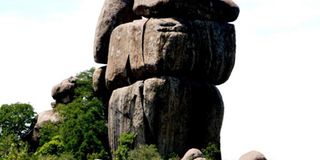Death at the shrine: Was it a case of suicide, accident or murder?

The spectacular view of Kit Mikayi rocks in Kisumu. FILE PHOTO |
It is a tale of violent death, rocky shrine and fleeing witnesses that has left villagers of Othany sub-location in Seme, Kisumu County, in shock.
They are trying to unravel what might have transpired in the wee hours of Sunday.
The authorities are also trying to piece together evidence that could reveal what led to the death of a worshipper in his mid-20s, who plunged more than 35 feet down from the historical Kit Mikayi rocks in Seme.
Following the tragedy, locals and staff working at the rocks are now asking for regulation of worshippers, who have turned the site into a shrine that they visit throughout the week.
The body of the man was discovered at the foot of Kit Mikayi, his white robe bloodied. Underneath, he wore a purple shirt and a pair of black trousers.
Blood was oozing from the nose, mouth and head.
According to those who helped the police to carry the body, the man likely fell face first on the ground, breaking his limbs on the trees and boulders at the foot of the popular rocks.
It is not clear whether it was a case of a prayer session gone wrong, a suicide or an accident, that saw the young man plunge to his death at around 2am on Saturday morning.
The worshipper was part of tens of others who arrived at the rocks on Saturday for an overnight prayer session.
The rocks are used as a shrine by many churches, whose faithful visit to pray and fast.
According to Mr John Ochieng, a security guard on duty when the incident happened, he was alerted by worshippers who had accompanied the victim before they fled under the cover of darkness.
“The man did not have any identification document on him, while those he was with vanished immediately after the incident,” said Mr Ochieng.
The mysterious death of the man has exposed the security inadequacies at the famous rocks.
Lack of a visitors’ book to trace those who accompanied the man and lack of witnesses and a national identification card on the body complicated the process of identifying the man and unearthing what went wrong.
His family was alerted of the incident, thanks to a phone that was in his pocket.
“We usually record the visitors who come to this site, however due to its porous nature since it is not fully fenced, some come in without our knowledge, pray and leave the site. This has made tracing visitors difficult,” said Mr Bernard Ndinya Magaga, a tour guide at the site.
He added: “I want to appeal to the county government of Kisumu to secure the rock by fencing the remaining areas and restricting access to the main entrance. It would have been easy to trace the people who were with the deceased if they had signed the visitors’ book."
While the presence of worshippers is significant and a boost to tourism sites, locals are, however, concerned that their continuous stay at the heritage site will slowly turn it into a death trap.
Mr Obuyu Ngeso, another tour guide, said sometimes the presence of the worshippers, who occasionally get ‘wild’ during the prayer sessions, scares some visitors.
The worshippers appear to have taken over Kit Mikayi, naming some sections after saints and prophets. They include Abraham, Daniel, Jacob, and Michael, while some have been named after the founder of the Legio Maria of African Church mission, Melkio Simeo Ondetto.
The tour guide complained that the worshippers have polluted some parts of the rocks with the candles they usually carry to the site.
Melted wax in all colours forms a shiny veneer on the rocks that have turned slippery — a danger to visitors. Mr Ngeso and his colleagues suspect, this is what might have led to the man’s death.
“We need to have the prayers regulated to at least a pilgrimage of once in a year, like what happens at Got Kweru in Migori County. When they are allowed every day, it will continue getting destroyed and putting lives at risk,” said Mr Ngeso.
A local administrator, Mr Absalom Oyoo of Othany sub location, announced that already, further prayer sessions had been suspended until investigations into the young man’s death are completed.
“We want the county government to secure this place. The security around and inside the rock compound should be enhanced, complete with day and night guards who will keep all information of visitors at the rock at all the times,” said Mr Oyoo.
Three years ago, Kit Mikayi was listed among world cultural heritage sites by United Nations Educational, Scientific and Cultural Organization (Unesco) alongside other sites in Bogota, Columbia.
Kit Mikayi (Dholuo for first wife’s stone) is a huge rock with three stones resting on top of each other. The Luo believe that Kit Mikayi is where the first woman lived.
The county government has since developed the area around the rock, paving the road that leads to the site, fencing some sections and installing solar powered street lights to illuminate it.
The body of the deceased was taken to Jaramogi Oginga Odinga Teaching and Referral Hospital mortuary, awaiting a post-mortem.





